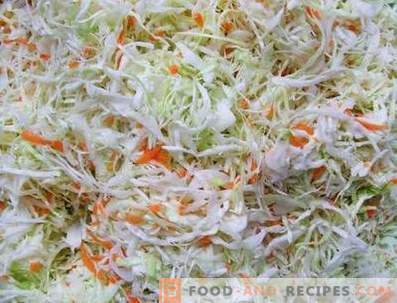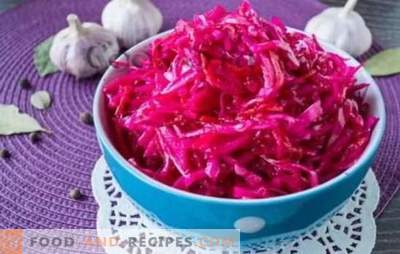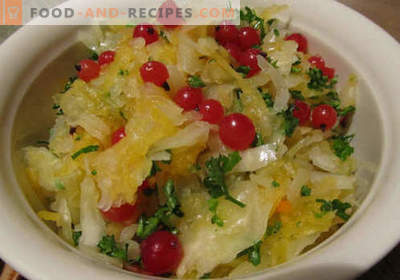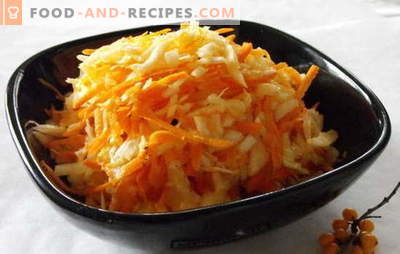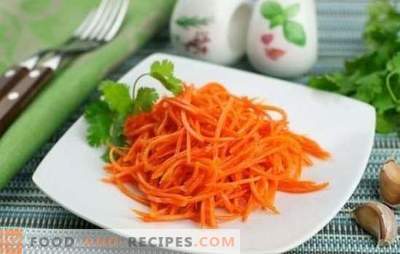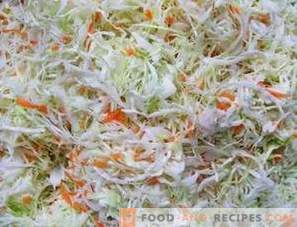
Sauerkraut - general principles and methods of cooking
How fertile cabbage, sour, crispy, slightly pink from carrots or beets, and, above all, incredibly tasty, is attractive and useful in winter. Our grandmothers believed that boiling cabbage was necessary on a growing moon, and even on days that have the letter “p” in their name - Tuesday, Wednesday, Thursday, and in no case do it on Sunday. By the way, in December 2012 the moon will grow from the 14th, so there is time to prepare and stock up on the product. When sauteing in cabbage almost all useful qualities are preserved. Juicy and crispy cabbage can be obtained with the addition of apples, cranberries, cranberries, bay leaf, cumin, sweet peppers and beets. Of course, you should not mix it all at once, consider several different recipes.
Useful properties of sauerkraut
Each vegetable has in its arsenal such a vitamin, which is its real calling card. In the case of white cabbage, it is methylmethionine - vitamin U. It is capable of treating gastric or duodenal ulcers, gastritis and many other intestinal diseases.
In sauerkraut cabbage is the leader in the content of vitamin C. It is interesting that this vitamin is stored in the same concentration for more than six months. No other vegetable has this property. The fact is that vitamin C is stored in a white one, not only in pure form, but also bound in form (ascorbigen). In this case, even heat treatment does not harm it, it simply turns into ascorbic acid.
Excellent helps sauerkraut with stress and intoxication of the body, overcomes infections and raises immunity. In addition, we can note the presence of vitamins of group B, K, and PP, potassium, enzymes, amino acids, minerals. This is not all the beneficial substances that we offer sauerkraut. Interesting information for those who want to lose weight - 100 grams of the product contains only 25 kilocalories, and a large amount of fiber removes toxins and toxins from the body.
Sauerkraut - food preparation
The main preservative in the preparation of cabbage is lactic acid. On the heads are natural lactic acid bacteria that convert the sugar contained in it into lactic acid. Alcoholic fermentation produces alcohol and carbon dioxide. But this is not enough to completely prevent rotting, therefore table salt is used as an additional preservative. For ferment, dense heads of late white varieties are selected, not less than 0.8 kg. Defective heads are not more than 5%. Among the countless varieties of the best-fit middle-ripening - kashirka, saburovka, Ladozhskaya, Belarusian, fame Gribovskaya, Mozharskaya, Altai glory. Late-ripe - nibble, late Moscow, licorice, Zavadovskaya, Slav, etc.
Sauerkraut - the best recipes
Recipe 1: Pickled Cabbage with Carrots
The most classic recipe that does not require much effort. Only - chop cabbage and carrots, wait a few days - and enjoy a healthy crispy salad until spring.
Ingredients: cabbage (3 kg), carrot (100 g), sugar (5 tablespoons), salt (70 grams).
Method of preparation
We clear the cabbage from the top leaves, chop straws with a special shredder or knife. Grate the carrot on a grater with large holes. Salt and rub with hands to get the juice, carefully tamped into a container, you can in large jars. Cover with gauze and put on top of the oppression. The container should be left in a warm place until foam appears on the surface. Remove the foam and make several deep punctures with the needle. Stir. Cabbage should ferment for 7 days, then it must be removed in a dark, cool place.
Recipe 2: Pickled Cabbage with Pumpkin and Herbs
For that recipe we use mint and tarragon. Pumpkin will give the dish its characteristic sweetish taste. Choose ripe fruit with orange pulp.
Ingredients: Cabbage (4 kg), sugar (3 tablespoons), salt 130 grams, mint and tarragon.
Method of preparation
Cut into large slices peeled pumpkin. Pour it with sugar and leave to highlight the juice. Shred cabbage, salt and grind. Finely cut the greens and mix with cabbage. In the prepared container lay out the cabbage, on top of the pieces of pumpkin. Cover all with a clean cloth and oppression, then leave at room temperature. After a few days you can try. We remove for storage in the refrigerator or cellar.
Recipe 3: pickled cabbage with peppers, tomatoes and zucchini
The principle of cooking is practically no different from the sauerkraut simple, but the vegetables are scalded with boiling water and laid in layers. Fill with brine and leave for some time at room temperature. The result is a wonderful salad of pickled vegetables. Store it in the refrigerator or cellar. Ingredients: cabbage (10 kg), sweet pepper (1 kg), tomatoes (1 kg), zucchini, carrots (5 pcs), garlic, parsley, cilantro, bitter pepper.
Method of preparation
Cut into 4 pieces of a head of cabbage and dip into boiling water. Do the same with pepper. Tomatoes and carrots are cut into slices. Peel the garlic, chop the greens. Put cabbage, zucchini, tomatoes, pepper into layers in an enamel pan. Each layer peppered garlic cloves and greens, lay a layer of carrots. Pour brine at the rate of 2 tablespoons of salt per liter of water. Vegetables cover with gauze and put the oppression. The cabbage will be ready in 3 days.
Recipe 4: Sauerkraut with Onions
This is a recipe for those housewives who like to thoroughly stock up for the winter. About 5 large white cabbage heads (20 kg) can be put even in a small barrel, as in the good old days. But you can take advantage of ordinary banks, it all depends on that. where do you plan storage.
Ingredients: cabbage (20 kg), onions (1 kg), carrots (600 g) salt (500 grams), sugar (30 grams).
Method of preparation
Chop cabbage in a classic way. Grind with salt and mix with chopped carrots (can be in the form of straw) and finely chopped onions. Sprinkle with ground black pepper and add sugar and bay leaf. Mix, put in a deep container and cover with plates with a load. Three days later, free the mixture from excess gases - pierce with a wooden needle and squeeze. Tightly laid for storage, clean in a cool place.
Recipe 5: Pickled Cabbage with Grapes and Honey
This cabbage is cooked very quickly, just a day. Honey and grapes give it an original sweetish taste. You can try to cook a small portion of such cabbage - all this will fit in a small three-liter enameled saucepan.
Ingredients: cabbage (2 kg), 1 kg grapes (1 kg), carrots (200 grams), basil (100 grams), honey (100 grams), salt (15 grams).
Method of preparation
Carrots and cabbage and chop on a shredder, mash with salt and put into a prepared container. Layers lay out the grapes and basil. Fill with boiling brine: 15 grams of salt per 1 liter of water, stir and add 100 grams of honey). Cover and leave for a day.
Recipe 6: Sauerkraut with Apples
Choose mature sourish apples of late varieties, preferably green.
Ingredients: cabbage (10 kg), 500 g apples (500 gr.) Dill seeds and cumin, salt (250-300 grams).
Method of preparation
Peel apples from skin and core. Cut into slices and mix with cabbage chopped and salted. Put in a container, layering the apples in layers and adding dill and cumin. Leave under the yoke for several days to ferment. Do not forget, cabbage must be helped to release gases - periodically pierce it deep into the bottom.
Sauerkraut - useful tips from experienced chefs
These are just a small part of the existing recipes for sauerkraut. The principle of cooking is almost the same - chop cabbage and ensure that it runs the juice. Taste depends more on additives. Here are some more options:
- Kalina: 10 kg of savoy cabbage need to take 1 kg of viburnum and 200 grams of dill. Salt is enough 200 grams.
- Horseradish: here you can taste everything by eye (for 1 head of cabbage add a head of garlic, carrot, salt and some sugar).
- Beet marinade: 2 kg of cabbage, garlic head, 1 sweet pepper. Marinade - 1/2 cup of vegetable oil for 1 liter of water, 1 tsp of vinegar, 3 spoons of sugar, 2 tablespoons of salt. Cabbage is poured with hot marinade and acquires a characteristic beet color. Such cabbage ferments without foam, due to the small content of vinegar, its readiness is determined by taste.
Enjoy your meal!
